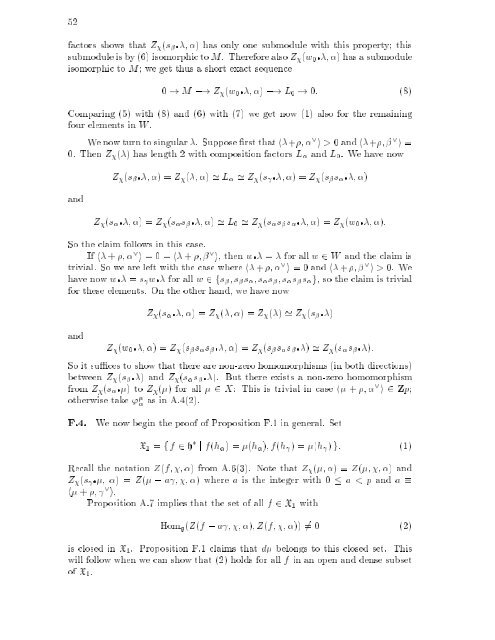subregular nilpotent representations of lie algebras in prime ...
subregular nilpotent representations of lie algebras in prime ...
subregular nilpotent representations of lie algebras in prime ...
You also want an ePaper? Increase the reach of your titles
YUMPU automatically turns print PDFs into web optimized ePapers that Google loves.
52<br />
factors shows that Z (s ; ) has only one submodule with this property; this<br />
submodule is by (6) isomorphic to M. Therefore also Z (w0 ; ) has a submodule<br />
isomorphic to M; wegetthus a short exact sequence<br />
0 ! M ,! Z (w0 ; ) ,! L0 ! 0: (8)<br />
Compar<strong>in</strong>g (5) with (8) and (6) with (7) we get now (1) also for the rema<strong>in</strong><strong>in</strong>g<br />
four elements <strong>in</strong> W .<br />
Wenow turn to s<strong>in</strong>gular . Suppose rst that h + ; _ i > 0 and h + ; _ i =<br />
0. Then Z ( ) has length 2 with composition factors L and L0. Wehave now<br />
and<br />
Z (s ; )=Z ( ; ) ' L ' Z (s ; )=Z (s s ; )<br />
Z (s ; )=Z (s s ; ) ' L0 ' Z (s s s ; )=Z (w0 ; ):<br />
So the claim follows <strong>in</strong> this case.<br />
If h + ; _ i =0=h + ; _ i, then w = for all w 2 W and the claim is<br />
trivial. So we are left with the case where h + ; _ i = 0 and h + ; _ i > 0. We<br />
have now w = s w for all w 2fs ;s s ;s s ;s s s g, so the claim is trivial<br />
for these elements. On the other hand, we have now<br />
and<br />
Z (s ; )=Z ( ; )=Z ( ) ' Z (s )<br />
Z (w0 ; )=Z (s s s ; )=Z (s s s ) ' Z (s s ):<br />
So it su ces to show that there are non-zero homomorphisms (<strong>in</strong> both directions)<br />
between Z (s ) and Z (s s ). But there exists a non-zero homomorphism<br />
from Z (s )toZ ( ) for all 2 X: This is trivial <strong>in</strong> case h + ; _ i2Zp;<br />
otherwise take ' as <strong>in</strong> A.4(2).<br />
F.4. We now beg<strong>in</strong> the pro<strong>of</strong> <strong>of</strong> Proposition F.1 <strong>in</strong> general. Set<br />
X1 = f f 2 h j f(h )= (h );f(h )= (h ) g: (1)<br />
Recall the notation Z(f; ; ) from A.6(3). Note that Z ( ; )=Z( ; ; )and<br />
Z (s ; )=Z( , a ; ; ) where a is the <strong>in</strong>teger with 0 a

















